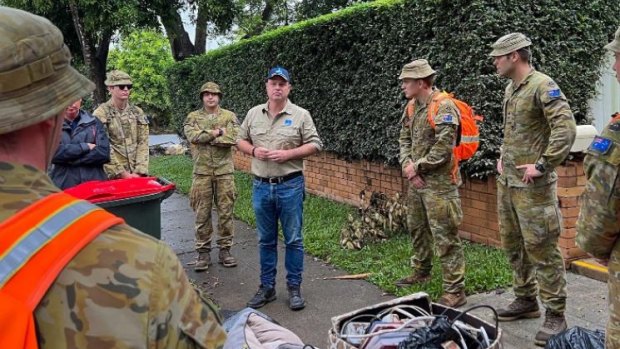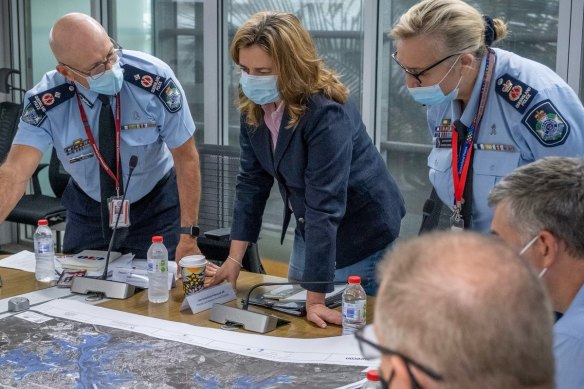This was published 3 years ago
Brisbane flood review recommends engineering solutions, more buybacks
By Tony Moore
Changes to planning laws and more backflow prevention devices across Brisbane’s stormwater system are among the immediate outcomes arising from a review of the February 2022 floods.
The floods inundated 23,000 homes and businesses, prompting a debate over planning laws - as well as a political stoush over disaster funding - and a council-commissioned review by former Queensland governor Paul de Jersey.

The extent of the flooding in Brisbane.
“It was a true calamity and many weeks down the track we see many people still displaced from their houses,” Mr de Jersey said.
“We see businesses that have closed down or closed their doors and the psychological scar is still raw.”
The review was released on Tuesday, with de Jersey calling for changes to planning laws and incentives for builders and body corporates to shift utilities - such as electricity systems - from basements to make buildings more flood-resilient.
De Jersey also recommended changes to the City Plan to govern the construction of private jetties, which added to the debris in the Brisbane River and in some cases exacerbated the damage.
Greater Brisbane’s February 2022 flood - what Paul de Jersey’s review found
- 23,400 properties in 177 suburbs were impacted; almost double the impact in the 2011 floods.
- Council’s SMS emergency alert system was inadequate, slow and reached only 14 per cent of residents.
- Confusion between council-supplied tweets, Facebook messages and tweets from local MPs.
- Review planning for the Pullenvale Ward - including Moggill and Bellbowrie - to improve flood relief.
- Brisbane needs more than two evacuation centres for natural disasters
- Voluntary Home Purchase Scheme be re-instated subject to federal and state funds.
Brisbane Lord Mayor Adrian Schrinner welcomed the review and accepted all 37 recommendations.
“We can’t prevent floods, but we can always be better prepared and Mr de Jersey’s review will be the blueprint that helps ensure that happens,” Schrinner said.

Defence personnel, shown with Brisbane Lord Mayor Adrian Schrinner, helped with the clean-up.Credit: Twitter/Adrian Schrinner
The council would also look to expand its flood buyback scheme, which acquired 112 badly damaged homes for $58 million after the 2011 floods but was short on funds.
“We will now look at adding additional areas to the program as well as expanding the eligibility to include business premises and apartment buildings,” Schrinner said.
“Both the federal and state governments have indicated they will support a new buyback scheme and I look forward to working with them on the program to ensure Brisbane properties most at risk of flooding are voluntarily acquired, just like council did previously.”
De Jersey also called for a review of the volunteer Mud Army clean-up group, which was delayed by a state government “stay at home” order and subsequently bypassed some suburbs because communities cleared their own properties.

Premier Annastacia Palaszczuk said the recent natural disasters to hit Queensland were the result of climate change.
Schrinner said only 14 per cent of Brisbane residents were signed up to the council’s early alert system and it would be improved in the coming civic budget.
“However, Mr de Jersey has also urged the state government to review its alert system to ensure it can more efficiently distribute warnings and I will be writing to the state to ask that it look into this issue as a matter of urgency,” he said.
Council opposition leader Jared Cassidy had repeatedly questioned why the flood advice to communities was so slow during the February disaster.
“Council’s early warning system failed people because contradictory information went out about river flooding and it failed people because no information went out about creek, over land flow and flash flooding.”
Shrinner tweeted regularly on the Saturday and Sunday as waters rose, but not all residents receive the lord mayor's tweets.
Tennyson Ward councillor Nicole Johnston welcomed the report by de Jersey, who is also a former chief justice.
“It is the first glimmer of hope that we will see all three levels of government reply in a substantive way to managing natural disasters,” she said.
“It is very clear today that Justice de Jersey believes this city should be doing more to address the practical recommendations to improve flood mitigation, to address the planning issues that are involved in developing on a flood plain.”
Johnston agreed warnings were non-existent in some cases.
“Residents I represent received no warning. There were no evacuation centres for them and the flood mitigation promised in 2011 wasn’t there for them.”